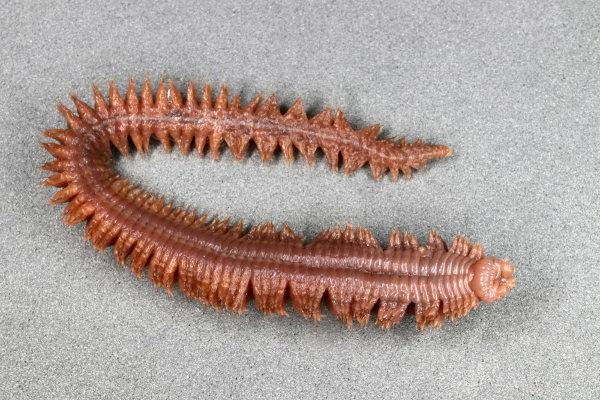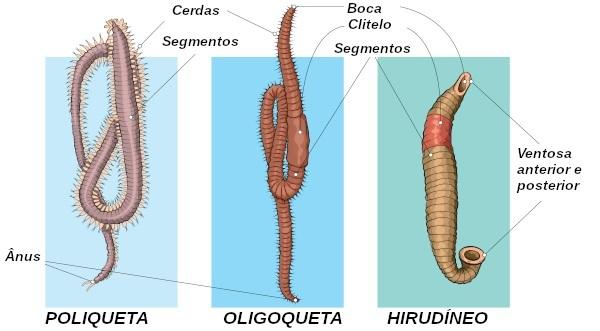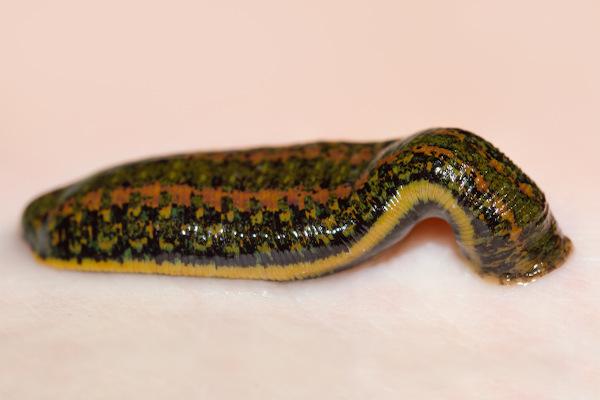annelids (Phylum Annelid) they are animals of segmented bodies that live in different environments, such as fresh water and moist soil. Currently, around 16,500 species are known, being the earthworm the best known representative. They are triblastic animals, coelomate and that have bilateral symmetry. The phylum is traditionally divided into polychaetes, oligochaetes and hirudines, one of the criteria for this classification being the presence of bristles.
Know more: Invertebrate animals - characterized by the absence of spine and skull
General characteristics of annelids
The annelids are animals that, as the name suggests, have the body formed by several segments that resemble a series of rings fused together. They live in varied environments, being found in marine environment, in fresh water and in moist soil. They have representatives of different sizes, existing organisms with less than 1 mm and even with more than 3 m, this being the case of the giant Australian earthworm.

annelids are animals triblastic (have three embryonic leaflets: endoderm, mesoderm and ectoderm), coelomate (they have a body cavity lined with tissue derived from the mesoderm called coelom) and protostomes (the blastopore gives rise to the mouth). Your body is soft and your coelom is full of liquid, thereby acting as a hydrostatic skeleton.
As mentioned, annelids present segmentation of the body, with septa separating such segments. The organization of the body into a series of similar segments is called a metamerism. The body of an annelid has three regions, called the prostomion, trunk and pygidium.
The anterior part of the body is called the prostomy and that's where the animal's brain is. O trunk it is formed by the segments of the animal and is where most systems are found. The terminal part of the body, in turn, is called the pigidium and this is where the anus is found.
Do not stop now... There's more after the advertising ;)
The body of the annelids is coated with a fibrous collagen cuticle, that covers an epithelium that presents glandular and sensory cells. The animal's body wall has layers of circular and longitudinal muscles.
O annelids digestive system is complete, starting in the mouth, located anteriorly, and ending in the anus, in the posterior region of the body. The digestive tract is tubular and extends throughout the animal's body, crossing each septum. Annelids feed on different products, existing species carnivores, herbivores and even parasites.

You circulatory system of these animals is closed, with the blood therefore running inside the vessels. O blood plasma it presents hemoglobin dissolved, this molecule being responsible for the transport of oxygen in the animal.
THE breathing of annelids can be performed in different ways. Some species have skin breathing, others, however, have gill breathing. In many polychaetes, there is the presence of structures called parapods, which act, among other functions, as gills. O excretory system of the annelids is formed by a pair of nephrids per segment. In most annelids, such as earthworms, the presence of metanephrids, structures that collect the liquid directly from the animal's coelom.
Annelids have a nervous system that is formed a pair of cerebral ganglia, also called the brain, and connectives to one or two nerve strands that run the entire length of the animal's body. In each segment, the presence of nerve ganglia and lateral nerves is observed.
Read too: Types of Animal Breathing
Classification of annelids
Annelids are traditionally classified into three groups: polychaetes, oligochaetes and hirudinians. Recent phylogenetic studies show some problems related to this division, but we will address the division into three groups as it is the most widespread.

Polychaeta (polychaetes): have marine representatives and with a lot of bristles on their body. They have a pair of appendages called parapods, which resemble oars and are rich in bristles. Parapods help with locomotion and, in some species, act as gills. They have separate sexes and fertilization is external. They have indirect development, that is, they have a larval stage. Polychaetes stand out for their great regeneration capacity.
Oligochaeta (oligochetes): this includes freshwater, marine and terrestrial annelids. Oligochaetes, as the name suggests, have a small amount of bristles on their body. To move around in wet soils, they contract your body or else, literally, eat your way. By feeding on the soil, these animals extract their nutrients, and what is not used is eliminated in the form of humus. oligochaetes are hermaphrodites, fertilization is cross-fertilization, and development is direct. In this group, there is the presence of a clythelium, which secretes a material that will form the cocoon that will contain the eggs. As representatives of oligochaetes, we can mention earthworms.

Hirudine (Hirudine): we have representatives of fresh water, salt water and terrestrial environment. Unlike other groups, Hirudine representatives do not have bristles on their bodies. Like oligochaetes, they do not have parapods. They are popularly known as leeches. Although they are well known for being hematophagous, not all leeches have this habit. In species that suck blood from other animals, there are jaws that resemble blades, which cut the skin of the host. Generally, the host does not feel pain as these animals secrete an anesthetic substance. In addition, the secretion of the hirudin, an anticoagulant substance. The leeches are hermaphrodites and also have a clitoris, which secretes a cocoon in some species. The cocoon can be deposited in the aquatic or terrestrial environment.
If you want to go deeper into the characteristics of these three groups, read: Classification of annelids.
By Vanessa Sardinha dos Santos
Biology teacher

